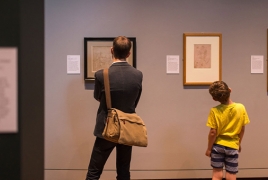
120 works by Raphael from international collections are on show at the Ashmolean this summer in the once-in-a-lifetime exhibition, Raphael: The Drawings, Art Daily reports.
Fifty works come from the Ashmolean’s own collection, the largest and most important group of Raphael drawings in the world. They arrived in 1845 following a public appeal to acquire them after the dispersal of the collection of the portrait painter Sir Thomas Lawrence (1769–1830), who had amassed an unrivalled collection of Old Master drawings. A further twenty-five works are on loan from the Albertina Museum, Vienna, which will show the exhibition in autumn 2017. The remaining drawings come from international collections and include The Head of a Muse (private collection) which broke the records when auctioned at Christies in 2009.
Dr Xa Sturgis, Director of the Ashmolean Museum, says: ‘Not since 1983, when an exhibition of drawings from British collections was on view at the British Museum, has such an extraordinary gathering of Raphael drawings been shown to the public. The generosity of lenders and supporters has enabled us to give people a ‘once in a generation’ opportunity - that of experiencing the visual and emotive power of Raphael’s hand, and of understanding Raphael’s genius.’
The 120 drawings on display are taken from across Raphael’s brief but brilliant career, taking visitors from his early career in Umbria through his radically creative years in Florence to the period when he was at the height of his powers in Rome, working on major projects such as the Vatican frescoes. The exhibition aims to transform our understanding of Raphael through a focus on the immediacy and expressiveness of his drawing. It shows how Raphael, throughout his career, engaged in an intensive search through drawing for possibilities of expression that would enable him to fulfil his far-reaching ambitions. Raphael often investigated and refined his ideas through the process and materials of drawing in ways that were more subtle or more adventurous than they would appear in his paintings, as in his nuanced portrayal of a youthful saint (c. 1505–7) that evokes not only a sculptural form, but an enigmatic, brooding character. Similarly, the breathtakingly accomplished red chalk folds that encircle and cling to the Madonna in the Studies for the Madonna of Francis I (c. 1518) were expressive details that would not translate to the final painting, but the act of making such elaborate drawings enabled Raphael to reflect deeply on the subject and its significance.
The challenges and opportunities presented by important commissions in Florence and above all in Rome saw Raphael forging through drawing a compelling and persuasive mode of visual communication, orchestrating ambitious narratives with inventive force. He was highly aware of the expressive potential of each drawing medium, including charcoal, earthy chalks, ink and metalpoint. Raphael’s drawings reveal processes of thinking, experimenting, recalling from memory, and revising, with gestures both rapid and considered, which attest to an embodied intelligence shaped by the nature of the medium.
At the height of his career and fame in Rome, when he not only became papal architect but also overseer of archaeological excavations, Raphael still used drawing as a mode of reflection and exploration, as well as making drawings of great refinement that were highly prized. That he was willing to offer finished designs as gifts to prestigious figures such as Duke Alfonso d’Este signalled a reciprocal recognition of their value as autonomous works of art. He chose to present the powerful sheet with Three Standing Men (c. 1515) to Albrecht Dürer. The German artist annotated the drawing, recording that Raphael sent it to him ‘to show him his hand’, a phrase that echoes Dürer’s concept of the ‘free hand’, the locus of talent, skill and creativity.
A further highlight is the sublime Study of the heads and hands of two Apostles of c.1519–20 relating to the Transfiguration altarpiece, arguably the most impressive drawing the artist ever made. This elaborate black chalk study exemplifies the ‘mute eloquence’ that Renaissance artists aspired to achieve in competition with poets and orators. The combination of moving facial expressions and articulate hand gestures conveys an immediate effect of ‘visible speech’. Through drawing, Raphael discovered an avenue of imaginative access to the feelings of his sacred protagonists who respond to disturbing events and are touched by divine light.
Dr Catherine Whistler, Keeper of Western Art, Ashmolean Museum, and exhibition curator, says: ‘RAPHAEL: THE DRAWINGS aims to shift the ground in our appreciation of Raphael by looking at his drawings as worlds in themselves, where we see the artist’s hand and mind in tune as thoughts take shape before our eyes through the process and materials of drawing. The idea of eloquence runs through the exhibition, not only in the shaping of Raphael’s powerful visual language but also in the tactile and gestural qualities of the drawings and in their expressive power - aspects that also make the drawings ‘speak’ in arresting ways to viewers today.’

